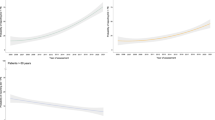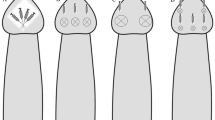Abstract
Data regarding the relation between premature ejaculation (PE) and post-circumcision mucosal cuff length are controversial. The aim of this study is to analyze the relation between post-circumcision mucosal cuff length/penile length ratio (MCR) and PE. After exclusion of patients with erectile dysfunction, penile deformity, history of penile surgery and severe lower urinary tract symptoms, 49 circumcised men with PE were included. The control group is constituted of 50 healthy volunteers with normal ejaculatory function. Self-estimated intravaginal ejaculation latency time (IELT) and premature ejaculation profile (PEP) measures of all subjects were recorded, and the MCRs of patients and controls were compared. The mean age of PE patients and controls was 35.82±7.73 (range 23–54) and 38.78±13.42 (range 19–71) years, respectively (P=0.183). Although mucosal cuff length was not associated with either self-estimated IELT (r=−0.185, P=0.067) or PEP (r=−0.098, P=0.336), there was a negative correlation between MCR and self-estimated IELT (r=−0.205, P=0.0001) and PEP measures (r=−0.308, P=0.002). The length of the mucosal cuff after circumcision may have an impact on ejaculatory function. Surgeons should avoid leaving excessive amount of mucosa during circumcision.
This is a preview of subscription content, access via your institution
Access options
Subscribe to this journal
Receive 8 print issues and online access
$259.00 per year
only $32.38 per issue
Buy this article
- Purchase on Springer Link
- Instant access to full article PDF
Prices may be subject to local taxes which are calculated during checkout
Similar content being viewed by others
References
Gross SW . Impotence. In: Gross SW, Practical Treatise on Impotence and Sterility and Allied Disorders of the Male Sexual Organs 3rd (edn). Lea Brothers and Company: Philadelphia, PA, USA, 1887 pp 29.
Porst H, Montorsi F, Rosen RC, Gaynor L, Grupe S, Alexander J . The premature ejaculation prevalence and attitudes (PEPA) survey: Prevalence, comorbidities and professional help seeking. Eur Urol 2007; 51: 816–824.
Laumann E, Paik A, Rosen R . Sexual dysfunction in the United States: prevalence and predictors. J Am Med Assoc 1999; 281: 537–544.
Althof SE, McMahon CG, Waldinger MD, Serefoglu EC, Shindel AW, Adaikan PG et al. An update of the International Society of Sexual Medicine’s Guidelines for the diagnosis and treatment of premature ejaculation (PE). J Sex Med 2014; 11: 1392–1422.
Serefoglu EC, McMahon CG, Waldinger MD, Althof SE, Shindel A, Adaikan G et al. An evidence-based unified definition of lifelong and acquired premature ejaculation: report of the second International Society for Sexual Medicine Ad Hoc Committee for the Definition of Premature Ejaculation. J Sex Med 2014; 11: 1423–1441.
Xin ZC, Choi YD, Rha KH, Choi HK . Somatosensory evoked potentials in patients with primary premature ejaculation. J Urol 1997; 158: 451–455.
Chia S . Management of premature ejaculation—A comparison of treatment outcome in patients with and without erectile dysfunction. Int J Androl 2002; 25: 301–305.
McMahon CG . The etiology and management of premature ejaculation. Nat Clin Pract Urol 2005; 2: 426–433.
Weiss HA, Thomas SL, Munabi SK, Hayes RJ . Male circumcision and risk of syphilis, chancroid and genital herpes: a systemic review and meta-analysis. Sex Transm Infect 2006; 82: 101–110.
Yegane RA, Kheirollahi AR, Salehi NA, Bashashati M, Khoshdel JA, Ahmadi M . Late complications of circumcision in Iran. Pediatr Surg Int 2006; 22: 442–445.
Drain PK, Halperin DT, Hughes JP, Klausner JD, Bailey RC . Male circumcision, religion and infectious diseases: an ecological analysis of 118 developing countries. BMC Infect Dis 2006; 6: 172–181.
Yang MH, Tsao CW, Wu ST, Chuang FP, Meng E, Tang SH et al. The effect of circumcision on young adult sexual function. Kaohsiung J Med Sci 2014; 30: 305–309.
Bronselaer GA, Schober JM, Meyer-Bahlburg HF, T’Sjoen G, Vlietinck R, Hoebeke PB . Male circumcision decreases penile sensitivity as measured in a large cohort. BJU Int 2013; 111: 820–827.
Senkul T, Iseri C, Sen B, Karademir K, Saracoglu F, Erden D . Circumcision in adults: effects on sexual function. Urology 2004; 63: 155–158.
Tarhan H, Can E, Akdeniz F, Akarken I, Cakmak O, Zorlu F . Relationship between circumcision scar thickness, postcircumcision mucosal cuff length measures and premature ejaculation. Scand J Urol 2013; 47: 328–332.
Serefoglu EC, Yaman O, Cayan S, Asci R, Orhan I, Usta MF et al. The comparison of premature ejaculation assessment questionnaires and their sensitivity for the four premature ejaculation syndromes: results from the Turkish society of andrology sexual health survey. J Sex Med 2011; 8: 1177–1185.
Symonds T, Perelman MA, Althof S, Giuliano F, Martin M, May K et al. Development and validation of a premature ejaculation diagnostic tool. Eur Urol 2007; 52: 565–573.
Dunsmuir WD, Gordon EM . The history of circumcision. BJU Int 1999; 83: 1–12.
Weiss H, Polonsky J, Bailey R . Male Circumcision: Global Trends and Determinants of Prevalence, Safety and Acceptability. World Health Organization Publications, 2007, http://whqlibdoc.who.int/publications/2007/9789241596169_eng.pdf. last visited on August 31, 2014.
Malkoc E, Ates F, Tekeli H, Kurt B, Turker T, Basal S . Free nerve ending density on skin extracted by circumcision and its relation to premature ejaculation. J Androl 2012; 33: 1263–1267.
Fink KS, Carson CC, DeVellis RF . Adult circumcision outcomes study: effect on erectile function, penile sensitivity, sexual activity and satisfaction. J Urol 2002; 167: 2113–2116.
Collins S, Upshaw J, Rutchik S, Ohannessian C, Ortenberg J, Albertsen P . Effects of circumcision on male sexual function: debunking a myth? J Urol 2002; 167: 2111–2112.
Masood S, Patel HR, Himpson RC, Palmer JH, Mufti GR, Sheriff MK . Penile sensitivity and sexual satisfaction after circumcision: are we informing men correctly? Urol Int 2005; 75: 62–66.
Hosseini SR, Khazaeli MH, Atharikia D . Role of postcircumcision mucosal cuff length in lifelong premature ejaculation: a pilot study. J Sex Med 2008; 5: 206–209.
Bodakci MN, Bozkurt Y, Soylemez H, Hatipoglu NK, Penbegül N, Atar M et al. Relationship between premature ejaculation and postcircumcisional mucosal cuff length. Scand J Urol 2013; 47: 399–403.
Veale D, Miles S, Bramley S, Muir G, Hodsoll J . Am I normal? A systemic review and construction of nomograms for flaccid and erect penis length and circumference in up to 15521 men. BJU Int 2014; 115: 978–986.
Rosen RC, McMahon CG, Niederberger C, Broderick GA, Jamieson C, Gagnon DD . Correlates to the clinical diagnosis of premature ejaculation: results from a large observational study of men and their partners. J Urol 2007; 177: 1059–1064.
Author information
Authors and Affiliations
Corresponding author
Ethics declarations
Competing interests
The authors declare no conflict of interest.
Rights and permissions
About this article
Cite this article
Yuruk, E., Temiz, M., Colakerol, A. et al. Mucosal cuff length to penile length ratio may affect the risk of premature ejaculation in circumcised males. Int J Impot Res 28, 54–56 (2016). https://doi.org/10.1038/ijir.2015.34
Received:
Revised:
Accepted:
Published:
Issue Date:
DOI: https://doi.org/10.1038/ijir.2015.34



